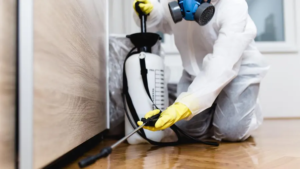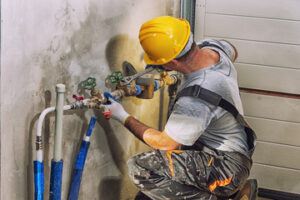An exterminator is a person who rids buildings and homes of pests. Their job description includes assessing a pest problem and developing treatment plans. They use both chemical and organic methods to control and eliminate pests in residential and commercial environments.
They also set traps and baits for rodents. They also perform structural repairs to keep rodents out. They also help customers create long-term prevention strategies. Contact Armis Pest Management now!

An exterminator is a professional who specializes in controlling pests, including insects like ants and cockroaches, and rodents such as mice and rats. They can be found in a variety of settings, from residential homes to industrial and commercial sites. In addition to treating for pests, they also provide recommendations on how to prevent them from returning to the property. They can use a variety of methods to control pests, including chemical treatments, traps, and exclusion techniques.
While many people associate the term “exterminator” with men in uniforms carrying spray cans, today’s exterminators are educated professionals who focus on environmentally conscious ways to vanquish pests. Some even specialize in specific types of pests, such as rodents or bees. For instance, you’ll want to hire a rodent exterminator if you have an infestation of mice or a bee exterminator if you notice bees swarming in your home.
In addition to traditional traps and poisons, some exterminators also employ less harmful methods such as ultrasonic sound waves and pheromone traps to repel certain pest species. They can also recommend natural or organic solutions to help you keep pests away from your home or business.
Some exterminators also work with businesses to develop long-term prevention strategies. These can include things like changing sanitation practices, implementing insect barriers, and sealing entry points into buildings. This type of pest control is particularly important in areas where pests are known to be more common, such as in warehouses and other large facilities.
Depending on the job, some exterminators may be required to wear protective equipment. This includes respirators, gloves, and other safety gear. This is especially true for those who work in industrial or warehouse settings where they may be exposed to dangerous chemicals.
In addition, some exterminators may be required to complete regular training and licensing requirements. These include certification in various safety procedures and an examination of their knowledge of different pest control methods. It’s important to find an exterminator who is licensed to apply pesticides safely and effectively. This ensures that you’re getting the best service for your money and that the pests are completely eradicated from your home or business.
Work environment
Working as an exterminator is not only rewarding but also challenging. People who choose this career are usually independent individuals who are stable, persistent, genuine, practical, and thrifty. These are the traits that make this profession one of the most sought after jobs in today’s job market. Those who are interested in becoming an exterminator should take a free career test to see if this is the right career choice for them.
Exterminators work in many different environments, including homes, office buildings, and commercial sites. They use a variety of methods to eliminate pests, including chemical treatments and traps. They also give recommendations to their clients on how to prevent pests in the future, such as improving sanitation and sealing cracks and gaps. This is a demanding job that requires physical stamina and good bookkeeping skills. However, most exterminators do not find their work stressful. They enjoy the satisfaction of being able to help customers solve their problems. They also like to be in control of their own schedule and working environment. Exterminators can work on their own or be part of a team, depending on the type of business they are in.
Education and training requirements
An exterminator’s career requires several types of training and education. Some are trained through on-the-job training, while others take courses in a vocational school or specialized college. These programs teach students about pest control methods and safety regulations. They also prepare students to pass the state’s certification exam. After completing the course, a student can start work as a general pest control technician. After gaining some experience, a student can move up to become a fumigator or an applicator.
The job of an exterminator is challenging and can be dangerous. They are often exposed to hazardous chemicals, so it is important that they follow strict safety protocols. They must be able to detect the smallest signs of pest infestation and find ways to keep them from returning. In addition, they need to be able to work with different types of equipment and confined spaces.
Many exterminators are self-employed, which allows them to set their own hours. However, they still have to meet the requirements of their employer. Exterminators also have to log their hours and the techniques they implement. This is why it is helpful to have good bookkeeping skills.
In New York City, pest exterminators are required to be licensed by the Department of Environmental Conservation. They must complete a Commercial Pesticide Applicator license to work in non-residential buildings, while a private pesticide applicator certificate is required to work in residential buildings. In some cases, a special license is needed to treat wood-destroying insects.
A career as an exterminator is a challenging and rewarding one. It offers the opportunity to make people’s lives more comfortable and safer by eliminating pests in their homes and businesses. In addition, it provides a great deal of flexibility, as some exterminators work part-time or seasonal jobs.
Whether you want to be an independent contractor or work for a big corporation, there are plenty of opportunities in this field. You can even start your own company down the road if you have the right qualifications. Those who enjoy working outdoors and love physical work may find this type of career to be the ideal fit for them.
Job outlook
Whether you’re looking for your first job or simply seeking out ways to make your current career more lucrative, working as an exterminator may be the right option for you. This position is considered a skilled trade and offers good pay and benefits. In addition, it is an extremely rewarding profession, as you help people solve pest problems and improve their quality of life.
In 2014, there were around 74,100 workers in this field and they provided pest control services for a variety of industries. These include businesses, schools, and government agencies. In addition to assisting commercial clients, these workers also provide pest control services for residential homes. Some workers work in the construction industry while others specialize in specific pests, such as rodents or termites.
The job outlook for this occupation is good, with an expected increase in demand. The growth rate is higher than that of most other jobs in the United States. Moreover, there are many opportunities for advancement in this industry, including the possibility of becoming an assistant to an exterminator.
As a skilled trade, an exterminator must be able to work well under pressure and be prepared to travel to sites where they will perform their duties. They should also be comfortable wearing protective equipment, such as goggles and gloves. Exterminators must also be able to log accurate records of the pest control techniques they use and financial transactions. They must also have excellent customer service skills to help clients. Additionally, this job requires physical stamina, as it often involves standing or crouching for long periods of time.


